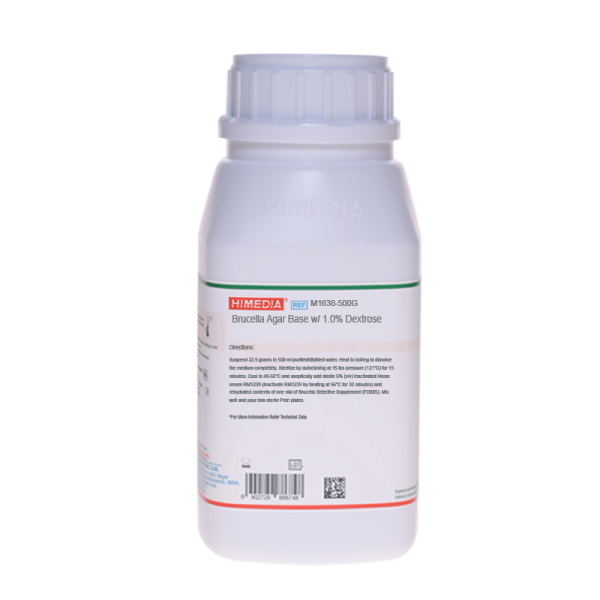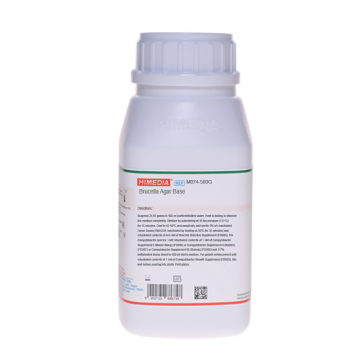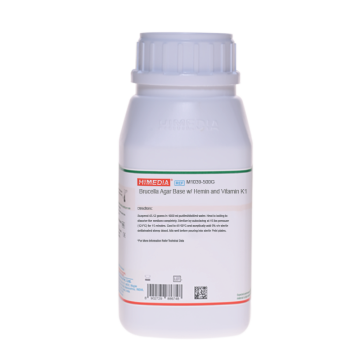 Your enquiry has been submitted
Your enquiry has been submitted
Brucella Agar Base w/ 1.0% Dextrose
Intended Use
Recommended for the cultivation and isolation of Brucella species.
Composition**
| Ingredients | g/ L |
|---|---|
| Peptone | 10.000 |
| HM extract # | 5.000 |
| Dextrose (Glucose) | 10.000 |
| Sodium chloride | 5.000 |
| Agar | 15.000 |
Final pH ( at 25°C) 7.5±0.2
**Formula adjusted, standardized to suit performance parameters
# Equivalent to Meat extract
Directions
Suspend 22.5 grams in 500 ml purified/distilled water. Heat to boiling to dissolve the medium completely. Sterilize by autoclaving at 15 lbs pressure (121°C) for 15 minutes. Cool to 45-50°C and aseptically add sterile 5% (v/v) inactivated Horse serum RM1239 (Inactivate RM1239 by heating at 56°C for 30 minutes) and rehydrated contents of one vial of NPBCVN Selective Supplement (FD005). Mix well and pour into sterile Petri plates.
Principle And Interpretation
Brucellosis is a zoonotic disease with a domestic animal reservoir. It is an occupational disease of veterinarians, microbiologists, farmers etc. The route of infections is genital, nasopharyngeal, gastrointestinal, conjunctival, respiratory and through abraded skin (1,2). Brucellosis in humans has a variable incubation period, an insidious or abrupt onset and no pathognomic symptoms or signs. Brucella Agar was designed for cultivating Brucella species from diagnostic specimens. With the incorporation of blood or other nutritious substances, it facilitates the cultivation of variety of fastidious anaerobic organisms (3). However, Brucella Medium is supplemented with antibiotics to prevent overgrowth of other accompanying organisms. Brucella Agar Base w/ 1.0% Dextrose was originally developed by Jones and Morgan (4) for preparations of serum-dextrose-antibiotic medium used for the isolation and cultivation of Brucella species.
The medium contains peptone and HM extract, which facilitates cultivation of variety of fastidious anaerobic organisms; by providing essential nutrients. Dextrose serves as source of energy. Addition of antibiotics (as FD) makes the medium highly selective for Brucella species. Ethyl violet and circulin, which were recommended initially, are no longer used (5).
Type of specimen
Clinical samples : vaginal secretions ; Dairy products
Specimen Collection and Handling
For clinical samples follow appropriate techniques for handling specimens as per established guidelines (6,7). For dairy samples, follow appropriate techniques for sample collection and processing as per guidelines (8,9). After use, contaminated materials must be sterilized by autoclaving before discarding.
Warning and Precautions
In Vitro diagnostic use. For professional use only. Read the label before opening the container. Wear protective gloves/protective clothing/eye protection/face protection. Follow good microbiological lab practices while handling specimens and culture. Standard precautions as per established guidelines should be followed while handling clinical specimens. Safety guidelines may be referred in individual safety data sheets.
Limitations
- Individual organisms differ in their growth requirement and may show variable growth patterns on the medium.
- All presumptive anaerobic organisms must be identified by confirmatory test.
Performance and Evaluation
Performance of the medium is expected when used as per the direction on the label within the expiry period when stored at recommended temperature.
Quality Control
Appearance Cream to yellow homogeneous free flowing powder
Gelling Firm, comparable with 1.5% Agar gel
Colour and Clarity of prepared medium Light yellow coloured, clear to slightly opalescent gel forms in Petri plates
Reaction Reaction of 4.5% w/v aqeuous solution at 25°C. pH : 7.5±0.2
pH 7.30-7.70
Cultural Response Cultural characteristics observed in presence of 10% Carbon dioxide (CO2) atmosphere with added 5% sterile inactivated horse serum and NPBCVN Selective Supplement (FD005), after an incubation at 35-37°C for 24-48 hours
| Organism | Growth |
|---|---|
| Brucella melitensis ATCC 4309 | luxuriant |
| Brucella suis ATCC 4314 | luxuriant |
| Escherichia coli ATCC 25922 (00013*) | inhibited |
| Staphylococcus aureus subsp. aureus ATCC 25923 (00034*) | inhibited |
Key : *Corresponding WDCM numbers.
Storage and Shelf Life
Store below 10-30°C in a tightly closed container and the prepared medium at 2-8°C. Use before expiry date on the label. On opening, product should be properly stored dry, after tightly capping the bottle in order to prevent lump formation due to the hygroscopic nature of the product. Improper storage of the product may lead to lump formation. Store in dry ventilated area protected from extremes of temperature and sources of ignition Seal the container tightly after use. Product performance is best if used within stated expiry period.
Disposal
User must ensure safe disposal by autoclaving and/or incineration of used or unusable preparations of this product. Follow established laboratory procedures in disposing of infectious materials and material that comes into contact with clinical sample must be decontaminated and disposed of in accordance with current laboratory techniques (6,7).
Reference
- Murray P. R., Baron E. J., Jorgensen J. H., Pfaller M. A., Yolken R. H., (Eds.), 8th Ed., 2003, Manual of Clinical Microbiology, ASM, Washington, D.C.
- Young E. J., 1983, Human Brucellosis, Rev. Infect. Dis., 5:821-842
- Atlas R. M., 1997, Handbook of Microbiological Media, 2nd Edi., Parks L.C. (Ed.), CRC Press, New York.
- Jones Lois M. and Brinley Morgan W. J., 1958, Bull. Wld. Hlth. Org., 19:200-203.
- Alton G. G. and Jones L. M., 1967, Lab Technique in Brucellosis, WHO, Geneva.
- Isenberg, H.D. Clinical Microbiology Procedures Handbook 2nd Edition.
- Jorgensen, J.H., Pfaller, M.A., Carroll, K.C., Funke, G., Landry, M.L., Richter, S.S and Warnock., D.W. (2015) Manual of Clinical Microbiology, 11th Edition. Vol. 1.
- American Public Health Association, Standard Methods for the Examination of Dairy Products, 1978, 14th Ed.,Washington D.C.
- Wehr H. M. and Frank J. H., 2004, Standard Methods for the Microbiological Examination of Dairy Products, 17th Ed.,APHA Inc., Washington, D.C.
| Product Name | Brucella Agar Base w/ 1.0% Dextrose |
|---|---|
| SKU | M1638 |
| Product Type | Regular |
| Physical Form | Powder |
| Origin | Animal |
| Packaging type | HDPE |
| References | 1. Murray P. R., Baron E. J., Jorgensen J. H., Pfaller M. A., Yolken R. H., (Eds.), 8th Ed., 2003, Manual of ClinicalMicrobiology, ASM, Washington, D.C. |
| Customized Product Available | No |











